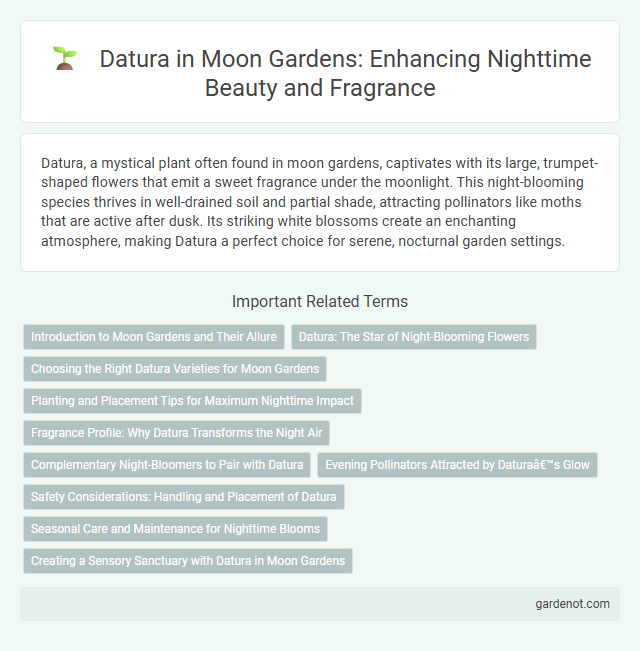Datura, a mystical plant often found in moon gardens, captivates with its large, trumpet-shaped flowers that emit a sweet fragrance under the moonlight. This night-blooming species thrives in well-drained soil and partial shade, attracting pollinators like moths that are active after dusk. Its striking white blossoms create an enchanting atmosphere, making Datura a perfect choice for serene, nocturnal garden settings.
Introduction to Moon Gardens and Their Allure
Datura, known for its striking trumpet-shaped flowers and intoxicating fragrance, is a captivating addition to moon gardens designed to bloom under the subtle glow of moonlight. This plant thrives in twilight conditions, enhancing nighttime garden aesthetics with its luminous white or pale blooms that attract nocturnal pollinators like moths. Incorporating Datura into a moon garden elevates the sensory experience, blending fragrance and visual appeal to create a serene and mystical outdoor retreat after dusk.
Datura: The Star of Night-Blooming Flowers
Datura, often called the star of night-blooming flowers, captivates with its large, trumpet-shaped blossoms that open at dusk and emit a sweet, intoxicating fragrance. This nocturnal flower thrives in warm climates and is prized for its striking white or pale yellow petals that glow under moonlight, creating a mystical garden atmosphere. Known for its potent alkaloids, Datura requires careful handling but remains a stunning centerpiece in moon gardens for its dramatic nighttime display.
Choosing the Right Datura Varieties for Moon Gardens
Selecting the right Datura varieties for moon gardens involves prioritizing white or pale-colored blooms like Datura inoxia and Datura metel, which enhance nighttime visibility and create an ethereal glow under moonlight. These species produce large, trumpet-shaped flowers with strong fragrance that attracts nocturnal pollinators such as moths. Opting for compact growth habits ensures the plants fit seamlessly into moon garden layouts while maintaining visual impact and ease of maintenance.
Planting and Placement Tips for Maximum Nighttime Impact
Datura thrives in well-drained soil with full to partial sunlight, making it ideal for moon gardens that glow under moonlight. Plant Datura in spots where its large, white, trumpet-shaped flowers can reflect light and attract nocturnal pollinators like moths. Placing this night-blooming plant near walkways or water features enhances its visual impact and fragrance, creating a captivating nighttime ambiance.
Fragrance Profile: Why Datura Transforms the Night Air
Datura releases a powerful, intoxicating fragrance composed of sweet, spicy, and slightly musky notes that intensify after dusk, creating a captivating nocturnal scent. Its scent molecules interact with cooler nighttime temperatures and higher humidity, which enhances the diffusion and longevity of its aroma in moon gardens. This unique chemical profile attracts night pollinators such as moths, making Datura a vital and enchanting component of nighttime botanical landscapes.
Complementary Night-Bloomers to Pair with Datura
Datura thrives alongside complementary night-bloomers such as Nicotiana, which offers fragrant tubular flowers that enhance evening garden scents. Moonflowers (Ipomoea alba) provide large, white, trumpet-shaped blooms that open at dusk, creating a striking visual contrast to Datura's blossoms. Pairing Datura with night-blooming jasmine (Cestrum nocturnum) can also intensify the nocturnal fragrance, enriching the sensory experience in moon gardens.
Evening Pollinators Attracted by Datura’s Glow
Datura emits a luminous fragrance that thrives in moonlit gardens, attracting a variety of nocturnal pollinators such as moths and bats. Its large, trumpet-shaped flowers open at dusk, providing a vital nectar source that supports evening ecosystems. This unique adaptation enhances pollination efficiency during nighttime, promoting biodiversity in lunar-inspired landscapes.
Safety Considerations: Handling and Placement of Datura
Datura contains toxic alkaloids that require careful handling to prevent accidental poisoning, especially around children and pets. Always use gloves when pruning or transplanting to avoid skin irritation or ingestion risks. Place Datura in secure, well-marked areas away from high-traffic zones to minimize unintentional contact or consumption.
Seasonal Care and Maintenance for Nighttime Blooms
Datura thrives in well-drained soil with regular watering during the growing season to support its large, fragrant nighttime blooms. Pruning spent flowers and deadheading encourages continuous blooming throughout summer and early fall. Protect the plant from frost and reduce watering in late fall to prepare for dormancy.
Creating a Sensory Sanctuary with Datura in Moon Gardens
Datura, known for its large, fragrant white blooms that open at dusk, transforms moon gardens into sensory sanctuaries by filling the night air with a sweet, intoxicating scent. This night-blooming plant thrives in well-drained soil and warm climates, creating a visually striking focal point under moonlight. Its captivating aroma and dramatic silhouette enhance nighttime garden experiences, inviting relaxation and sensory exploration.
Datura Infographic

 gardenot.com
gardenot.com